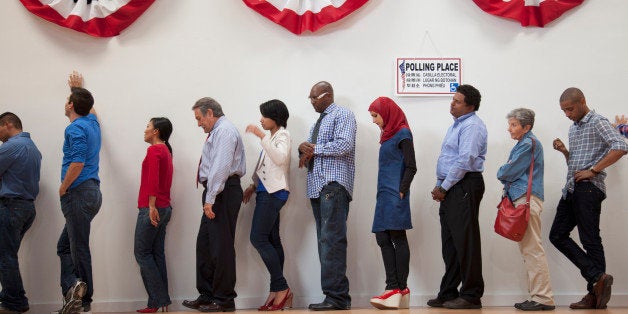
Does it matter that the wealthy turnout to vote at a rate of almost 99% while those making below $10,000 vote at a rate of 49%? It sure seems like it would, but for a long time many political scientists and journalists believed it didn't. In their seminal 1980 study on the question (using data from 1972) Raymond Wolfinger and Steven Rosenstone argued that, "voters are virtually a carbon copy of the citizen population." In a 1999 study, Wolfinger and Benjamin Highton find a slightly larger gap between voters and nonvoters, but still conclude, "non-voters appear well represented by those who vote."
This argument has been largely assimilated by pundits and also non-voters, 59% of whom believe "nothing ever gets done," and 41% of whom say "my vote doesn't make a difference anyway."
But more recent research suggests that the logic of wealth voters is sound -- and that if the poor and middle class turned out at a higher rate, policy would shift leftward on economic policy. The most importantstudy on the question is by Jan Leighley and Jonathan Nagler. They revisit the Wolfinger/Rosenstone thesis and find that, in fact, non-voters are not, "a carbon copy" of the voting electorate as previously assumed. They find that, "notable demographic, economic, and political changes that have occurred in the U.S. since Wolfinger and Rosenstone's classic statement [their 1980 book, "Who Votes"]." The most important difference that Leighley and Nagler find is that:
After 1972, voters and non-voters differ significantly on most issues relating to the role of government in redistributive policies. In addition to these differences being evident in nearly every election since 1972, we also note that the nature of the electoral bias is clear as well: voters are substantially more conservative than non-voters on class-based issues
That is, after the New Deal consensus eroded, policy views became more polarized along class lines and the class-skewed nature of the electorate began to matter considerably. Non-voters skew left on a variety of issues:
A Public Policy Institute of California (PPIC) study of Californians from 2006 finds that non-voters are more likely to support higher taxes and more services. They are also more likely to oppose Proposition 13 (a constitutional amendment which limits property taxes) and to support affordable housing (a more recent study finds similarly). More recently, a 2012 Pew study that examined likely voters and non-voters finds a strong partisan difference. While likely voters in the 2012 presidential election split 47% in favor of Obama and 47% in favor of Romney, 59% of non-voters supported Obama and only 24% supported Romney. The study also found divergence on other key policy issues, including healthcare, progressive taxation and the role of government in society.
The ideological turnout gap seems strongly related to the economic divide in voting behavior. A recent study by William Franko, Christopher Witko and Nathan Kelly examined 30 years of data for all 50 states. They find no instances in which low-income voter turnout was higher than high-income voter turnout. Across midterm and presidential elections, Census data show strong gaps between turnout rates between those earning above $150k and those earning less than $10k (a 32.6 point gap in 2008, a 34.9 point gap in 2010).
There is evidence that this affects the political system. Consider a recent study by David Broockman and Christopher Skovron finds that politicians believe that their constituencies are significantly more conservative than they are. Such a bias should be impossible to sustain - politicians have strong electoral incentives to gauge their constitutents' views correctly. Once we understand that voters are more conservative than non-voters, the puzzle disappears. Politicians's real constituents are the people who vote -- a disproportionately affluent and conservative slice of the population.
Conversely, where the electorate is less skewed policy outcomes shift left. In a recent study William Franko, Nathan J. Kelly and Christopher Witko find that "where the poor exercise their voice more in the voting booth relative to higher income groups, inequality is lower." In another study, Franko examined voting gaps and policy outcomes in three areas -- minimum wages, anti-predatory lending laws and SCHIP (State Children's Health Insurance Program). He finds that states with smaller voting gaps across incomes had policies more favorable to the poor. States with low turnout inequality have a higher minimum wage, stricter lending laws and more generous health benefits than those with high turnout inequality.
The design and benefit levels of many social safety net programs such as Temporary Assistance for Needy Families (TANF), are decided at the state level, which provides a natural experiment to test how turnout inequality affects policy. James Avery and Mark Peffley find that, in states with higher rates of low-income voting, politicians were less inclined to pass restrictive eligibility rules for social benefits. Political scientists Kim Hill and Jan Leighley find in two studies that states with a more pronounced turnout bias, social welfare spending is lower. Thus, the evidence confirms what theory would predict: closing low-income voting gaps is consequential for public policy, in favor of lower-income households.
This piece originally appeared on Vox.
